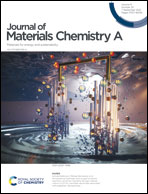Superior photo-piezoelectric catalytic performance using Bi0.5Na0.5TiO3@BiVO4 based cloth†
Abstract
Piezoelectric materials were proven as a promising candidate to improve the efficiency of photocatalysis degradation activity via preventing the recombination of photoelectron–holes by stress-induced electric potential. In this work, core–shell structured catalytic agents consisting of lead-free piezoelectric ceramics Bi0.5Na0.5TiO3 (BNT) and photoelectric materials BiVO4 (BVO) were prepared by a hydrothermal method. The BNT@BVO powders were employed in the degradation of organic dye Rhodamine B (RhB) and exhibited superior catalytic activity due to the piezo-photoelectronic coupling effect. High first-order rate constants k of 0.110 min−1 and 0.045 min−1 were achieved for RhB solution with the initial concentrations of C0 = 5 mg L−1 and 10 mg L−1, respectively. To overcome the difficulties of powder recovery in applications, a series of macroscopic cloths with different BNT@BVO filler loadings and thicknesses were fabricated via an electrostatic spinning route. The degradation efficiency of RhB solution (C0 = 10 mg L−1) by a piece of BNT@BVO cloth (∼50 cm2) reached 80% in 100 min with a first-order rate constant of 0.015 min−1. In order to reveal the charge transfer mechanism in the interface layer between piezoelectric materials and photoelectric materials, a series of photoelectrochemical measurements were carried out. The conduction band (CB) position of BNT was bent from −1.1 eV towards −0.8 eV after being coated with BVO, which means less energy was required to be absorbed for the charge transition from the valence band (VB) to CB for the BNT and BNT@BVO have the same VB, resulting in a higher electron–hole separation efficiency. The enhancement of current density after coating with BVO from 2.3 μA cm−2 to 4.9 μA cm−2 (about 110% higher than that of pure BNT) at a potential of 1.23 V (vs. RHE) further verifies that the coupling between BNT and BVO has significant influence on charge separation efficiency.



 Please wait while we load your content...
Please wait while we load your content...